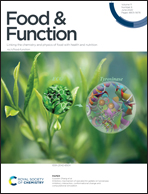Bergaptol from blossoms of Citrus aurantium L. var. amara Engl inhibits LPS-induced inflammatory responses and ox-LDL-induced lipid deposition†
Abstract
Aberrant activation of inflammation and excess accumulation of lipids play pivotal roles in atherosclerosis (AS) progression. Constituents from Citrus aurantium Linn variant amara Engl (CAVA) were effectively investigated for their various bioactivities, especially anti-inflammation. Bergaptol (BER) is particularly abundant in Citrus products. Accumulating studies have confirmed its predominant anti-cancer and antioxidant functions, whereas few studies focused on its antiatherogenic functions. In the current study, BER was isolated from CAVA for the first time. Macrophages were stimulated with lipopolysaccharides (LPSs) or oxidized low-density lipoproteins (ox-LDL) to mimic inflammatory responses and AS development. BER treatment significantly inhibited LPS-induced production of nitric oxide (NO), interleukin-6 (IL-6), and tumor necrosis factor-α (TNF-α), and gene expression of inducible nitric oxide synthase (iNOS), IL-6, TNF-α, interleukin-1 beta (IL-1β) and cyclooxygenase-2 (COX-2). BER also potently blocked LPS-induced mitogen-activated protein kinase (MAPK) phosphorylation and nuclear factor-kappa B (NF-κB) activation, as evidenced by the inhibitory effects on c-Jun N-terminal kinase (JNK), P38, P65, IκBα and IκKα/β phosphorylation, and NF-κB nuclear translocation. Furthermore, BER treatment markedly mitigated ox-LDL-induced foam cell formation by inhibiting scavenger receptor class A type I (SRA1) and cluster of differentiation 36 (CD36)-dependent cholesterol uptake. In conclusion, BER might be a novel therapeutic agent for AS prevention through inhibiting inflammatory responses and cholesterol uptake.

- This article is part of the themed collection: Food & Function Recent HOT articles


 Please wait while we load your content...
Please wait while we load your content...